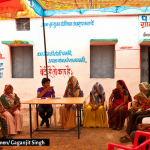
E-Governance and Decentralisation
7 October 2022
The economist Jack Waldon made an astute, if somewhat cynical observation, in the context of democratic decentralisation through multi-level governments. He said that if governance is largely about managing spill-over effects, and if the central government could do so effectively through allocating its resources, then multi-level governments and decentralisation are unnecessary and wasteful. That observation, though buried in a mountain of citations contained in defining papers on decentralisation, has a strong bearing on how we govern ourselves today.
When the above observation was made, the possibility that a central government could actually, in practice, manage all spill-overs in governance, was still only a remote possibility. That is no longer the case today, and the difference has been largely through the implementation of large-scale e-Governance projects.
Take the case of pinpointed support to every poor family. In the past, anti-poverty programmes were transaction heavy – they involved policy setting at the highest level, in matters such as the subsidies that could be given to each family, the budgetary limits, the allocation and releases of funds, and so on. While guidelines were set on how to select the poor eligible to receive benefits, the actual selection of beneficiaries and the day-to-day management of such programmes were left to the states. They in turn delegated the work to the local governments, to a greater or lesser degree depending upon the state.
All that has changed now.
With the advent of IT and the possibility of maintaining large databases, intelligent analyses, and coupled with the ability to deliver monies directly to people through electronic means, the decision-making on how local programmes are to be run, has been withdrawn to central levels. We see Waldon’s observations now playing out in practice; Information Technology has become how nearly all spill-over externalities can be managed, thus marginalising local interventions through local governments. They are only front offices now, for the large, centrally managed programme.
Examples of this approach are numerous. Nearly every welfare programme now is dependent upon central databases. The Below the Poverty Line (BPL) list centralisation started two decades back but was inhibited in its full implementation because of the lack of IT capability at the time. Once the BPL list became more and more refined, through the application of the Aadhar system which promised de-duplication and through the opening of bank accounts for each individual, it became possible to deliver a wide range of subsidies to the poor, ranging from direct cash transfers to housing subsidies.
Have all problems been solved? Certainly not, by a long measure. The Aadhar system is still imperfect, duplicate numbers are issued, fake numbers still are detected, and those without access to the system are left to suffer. All this could have been avoided through the adoption of a highly decentralised system of local identification of the eligible through Gram Sabhas, but that is considered unfashionable and backward by the tech-savvy, who now rule the roost in governance.
The tech-savvy also turn their faces away from the fact that IT governance cannot solve basic problems. For instance, if there is no money to give out to run welfare programmes, IT enabling won’t set that right. The NREGA programme has a well-designed and well running IT enabled management system, which enables the country to keep track of the hundreds of thousands of works undertaken all over, plus the wage entitlements of millions of people undertaking manual work under the programme. But if there is a budget shortfall and bills don’t get paid, they don’t get paid. That’s it.
Still, it seems that the move towards management of all externalities through IT enabling is an inexorable force. It does create transitional contradictions and may put the clock back on efficiency, but there is no way that we are going to give up our efforts.
Just how contradictory IT enabling of processes can be, was brought home to me recently, when I visited a Regional Transport Officer to obtain a fitness certificate for a vintage car — I am an enthusiast who restores them in my spare time.
Recently, the Government of India has come out with a vintage vehicle protection policy, which exempts vehicles over 50 years old, which are defined as ‘Vintage’, from the scrappage policy. Under the latter, all vehicles over 15 years old are to be subject to automatic fitness tests. If they fail such tests, they shall be scrapped. Even those vehicles that pass these fitness tests, are to pay an enhanced fee to continue to be used on the roads.
In the meantime, the details of all vehicles have been uploaded into a giant all-India electronic database. Considering that we have 32 crore vehicles in India, that is an effort that equals the Aadhar effort. It is a commendable endeavour of a staggering scale.
But here is the bottom line. Most of the data pertaining to vintage vehicles are faulty. In the case of my car, not only were most of the technical details wrong but so was the date of registration, the name of the owner, and so on. This, I was told, was the case with much of the database.
However, what is the solution to this problem? The government has adopted severe centralisation as the answer.
Since the RTOs were considered unreliable, all data entry and corrections have been centralised to the head office of the Transport Commissioner at the state level. That office is inundated with genuine requests to correct the wrong databases, and that in turn causes interminable delays.
And we all know what happens when matters are delayed in government offices. Speed money exchanges hands.
T.R. Raghunandan is an Advisor at the Accountability Initiative.
Also Read: A Crisis of Conscience: Civil Servants & Freedom of Expression





